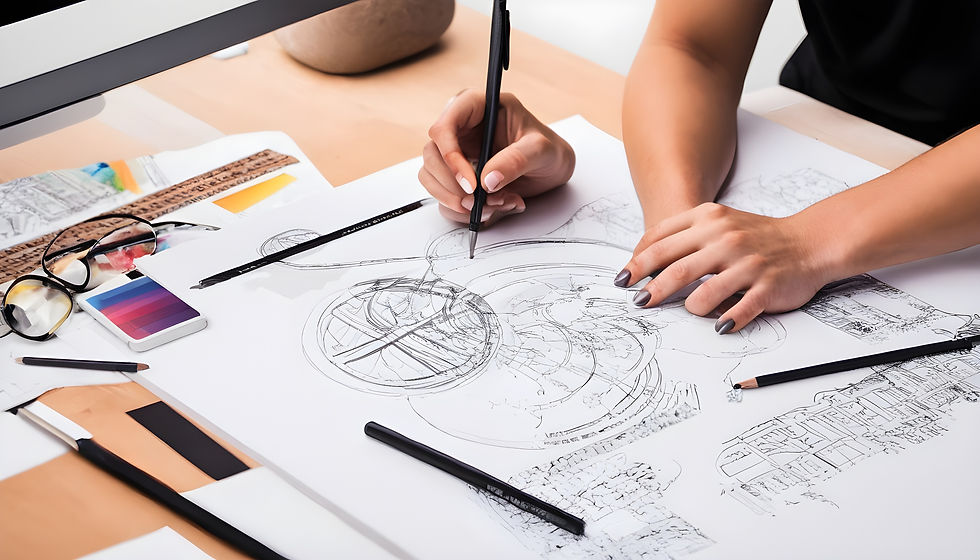How Artificial Intelligence is Empowering Graphic Designers
- Abhijit J K

- Mar 16, 2024
- 3 min read
The world of graphic design is a vibrant ecosystem where human creativity reigns supreme. But with the ever-evolving landscape of technology, a new force is emerging to augment and empower designers: Artificial Intelligence (AI).
This isn't a story of AI replacing designers. Instead, it's a tale of a powerful partnership, where AI acts as a tireless assistant, freeing designers to focus on the aspects that truly require human ingenuity.
So, how exactly is AI transforming the graphic design industry? Let's delve into the many ways AI is injecting creativity into the design process.

Supercharging Efficiency: Freeing Up Time for the Good Stuff
The design workflow can be bogged down by repetitive tasks like background removal, basic photo editing, and resizing images for different platforms. These tasks, while necessary, can be time-consuming and tedious.
AI-powered tools are stepping in to automate these repetitive actions. Imagine spending less time on mundane edits and more time on brainstorming compelling concepts, crafting unique layouts, and refining your visual storytelling.
Here are some specific examples of how AI is boosting efficiency:
Automated Image Editing: AI algorithms can now expertly remove backgrounds, enhance image quality, and even upscale low-resolution images for print. Tools like Adobe Sensei can perform these actions in seconds, freeing designers from tedious manual adjustments.
Smart Content Distribution: Creating graphics for various social media platforms with specific size requirements used to be a headache. AI-powered tools can now automatically generate different sized versions of your design optimized for each platform, saving designers significant time and effort.
Content Generation on Autopilot: Some AI tools can generate basic layouts and mockups based on keywords or design themes. This allows designers to quickly explore different design directions and get a head start on their projects.
By tackling these time-consuming tasks, AI becomes a valuable assistant, allowing designers to dedicate more energy to the strategic and creative aspects of their work.

From Inspiration to Innovation: AI as a Creative Muse
AI isn't just about automation; it's also about sparking creativity. Imagine having a design muse at your fingertips, constantly generating new ideas and variations to fuel your creative process.
Here's how AI is igniting design inspiration:
AI-Powered Design Exploration: Stuck in a creative rut? AI tools can help! By analyzing design trends, user preferences, and successful design elements, AI can suggest layouts, color palettes, fonts, and even generate variations of your initial ideas. This allows designers to explore a wider range of possibilities and overcome creative blocks.
Data-Driven Design Decisions: Design choices shouldn't be made in a vacuum. AI can analyze vast amounts of data to understand user preferences and market trends. This data can then be used to inform design decisions, ensuring that the final product resonates with the target audience.
Unleashing the Power of Generative Art: AI is pushing the boundaries of design by generating entirely new visual elements. From creating unique patterns and textures to crafting surreal imagery, AI can provide designers with a wealth of unexpected design elements to incorporate into their work.
This data-driven and inspirational approach allows designers to create visuals that are not only aesthetically pleasing but also strategically effective.
Elevating Collaboration: AI as the Bridge Between Designers and Clients
The design process is often a collaborative effort between designers and clients. AI can bridge the communication gap and ensure that everyone is on the same page.
Here's how AI is enhancing design collaboration:
Personalized Design Recommendations: AI can analyze client feedback and preferences, suggesting design revisions that align with their vision. This can lead to a more streamlined design process with fewer rounds of revisions.
Real-Time Feedback and A/B Testing: AI tools can analyze user responses to different design elements in real-time. This allows designers and clients to make data-driven decisions about which design variations perform best.
Accessibility and Inclusivity: AI can assist in creating designs that are accessible to a wider audience by suggesting features that cater to users with disabilities. This ensures designers consider inclusivity from the very beginning of the design process.
By facilitating clear communication and data-driven decision-making, AI fosters a more productive and collaborative design environment.
Beyond the Hype: The Future of AI and Graphic Design
While AI is undoubtedly transforming the design industry, it's important to remember that it's a tool, not a replacement for human creativity. The true power lies in the synergy between AI and human designers.
Here's a glimpse into the future of AI-powered design:
Hyper-Personalization: AI will become even more sophisticated, allowing designers to create hyper-personalized experiences for individual users. Imagine dynamic layouts and visuals that adapt to a user's preferences in




Comments